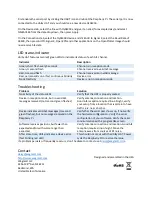
WEGMATT
LLC
dAISy HAT AIS Receiver
Quick Start Guide
Thank you for purchasing the dAISy HAT AIS Receiver for Raspberry Pi.
Disclaimer:
dAISy HAT is a reliable, dual-channel AIS Receiver. However, under no circumstances it
should be solely
relied on for collision avoidance or navigation. It’s the user’s responsibility to use the
product prudently. Neither Wegmatt LLC nor its dealers accept responsibility or liability to the product
user or their estate for any accident, loss, injury or damage whatsoever arising out of the use of this
product.
Please refer to the manual on our website
for more detailed instructions.
Installation
The dAISy HAT communicates with the Raspberry Pi through the serial port pins (8, 10) on the expansion
header. By default, the serial port of the Raspberry Pi is used for Bluetooth and must be reconfigured.
Raspberry Pi OS
If you are running Rasperry Pi OS, use the
shell script by Ilker Temir to configure the serial
port. Open a terminal window on your Raspberry Pi and execute the following commands:
wget https://github.com/itemir/rpi_boat_utils/raw/master/uart_control/uart_control
chmod +x ./uart_control
sudo ./uart_control gpio
sudo reboot now
After completing the reboot, AIS data is available using the following parameters:
Serial port
/dev/serial0
Baud rate
38400
Data bits
8
Parity
None
Stop bits
1
Flow control
None
Use this information to configure OpenCPN or other programs. Keep in mind, that only one application
at a time can consume serial data. dAISy immediately starts receiving AIS messages when powered up.
When connecting to dAISy with a serial terminal (e.g. screen), you can press ESC to enter a debug and
configuration menu. In this menu you can control the function of the 2
nd
serial port.
OpenPlotter
If you are running OpenPlotter, use the Serial app to configure the connection with the dAISy HAT.




















